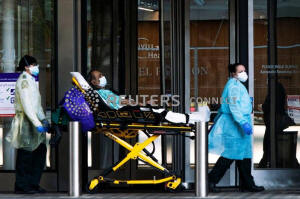Researchers double U.S. COVID-19 death forecast, citing eased
restrictions
 Send a link to a friend
Send a link to a friend
 [May 05, 2020]
By Maria Caspani and Nathan Layne [May 05, 2020]
By Maria Caspani and Nathan Layne
NEW YORK (Reuters) - A newly revised
coronavirus mortality model predicts nearly 135,000 Americans will die
from COVID-19 by early August, almost double previous projections, as
social-distancing measures for quelling the pandemic are increasingly
relaxed, researchers said on Monday.
The ominous new forecast from the University of Washington's Institute
for Health Metrics and Evaluation (IHME) reflect "rising mobility in
most U.S. states" with an easing of business closures and stay-at-home
orders expected in 31 states by May 11, the institute said.
"We expect that the epidemic in many states will now extend through the
summer," the IHME director, Dr. Christopher Murray, said in a statement.
The projections reinforced warnings from public health experts that a
rising clamor to lift restrictions on commerce and social activities -
in hopes of healing a ravaged economy - could exact a staggering cost in
terms of human lives.
The novel coronavirus is already known to have infected almost 1.2
million people in the United States, including 68,762 who have died from
COVID-19, the respiratory illness it causes, according to Reuters' own
tally.

The institute's predictive coronavirus model, periodically revised to
account for changing circumstances and scientific insights surrounding
the pandemic, has become an influential data point often cited by the
White House and public health authorities in gauging the crisis.
The IHME projections are presented as a statistical range of outcomes.
The latest forecast predicts the cumulative number of U.S. deaths from
COVID-19 will run from as few as 95,092 to as many as 242,890 by Aug. 4
- with 134,475 lives lost representing the most likely, middle ground.
By comparison, the previous revision issued on April 29 put the
middle-case figure at 72,400 deaths, within a range between 59,300 and
114,200 fatalities.
EASED SOCIAL DISTANCING
The upward spike reflects increasing human interactions as more states
begin to ease social-distancing requirements - the chief public health
tool available to curb the spread of a highly contagious virus for which
there is no vaccine and no cure.
The relaxation of social-distancing rules will more than offset any
decline in transmissions that might come from warmer weather and
stronger containment measures, such as more wide-scale testing and
tracing the contacts of infected people so they too can be tested and
isolated, Murray said.
The revised IHME projections coincided with disclosure of an internal
Trump administration forecast predicting a surge in COVID-19 cases
killing 3,000 Americans a day by the end of May, up from a current daily
toll that a Reuters tally places at around 2,000.
That projection, first reported by the New York Times and confirmed by a
Reuters source, also forecast about 200,000 new coronavirus cases each
day by the end of the month, up from the current rate of about 25,000
cases every 24 hours.
TRUMP'S PREDICTIONS
Asked about the confidential forecast, White House spokesman Judd Deere
said: “This is not a White House document, nor has it been presented to
the Coronavirus Task Force or gone through interagency vetting."
[to top of second column]
|

Health workers move a patient wearing a face mask at the at NYU
Langone Hospital, during the outbreak of the coronavirus disease
(COVID-19) in the Manhattan borough of New York City, New York,
U.S., May 3, 2020. REUTERS/Eduardo Munoz

President Donald Trump has given varying predictions for the number
of people in the United States who will succumb to COVID-19. As
recently as Friday, he said he hoped fewer than 100,000 Americans
would die, and had talked last week of 60,000 to 70,000 deaths.
But on Sunday night, the president acknowledged the death toll may
climb much higher.
“We’re going to lose anywhere from 75, 80 to 100,000 people. That’s
a horrible thing,” he told Fox News.
In New York, the state that accounts for about a third of all U.S.
infections, Governor Andrew Cuomo on Monday outlined plans to ease
restrictions on a regional basis.
Without giving a specific time frame, Cuomo told a daily briefing
that construction, manufacturing and the wholesale supply chain
would be allowed to start up under the first phase of a four-step
return to normality.
A second phase would permit insurance, retail, administrative
support and real estate businesses to open again, followed by
restaurants, food services, hotels and accommodation businesses in
the third stage, Cuomo said. In the final phase, arts, entertainment
and recreation facilities and education would restart.
Cuomo suggested that rural parts of New York might be relaxed ahead
of "higher-risk regions," including New York City.
California Governor Gavin Newsom said on Monday he would ease the
state's stay-at-home orders by Thursday, expanding the number of
retail businesses that can provide curbside services.
"This is an optimistic day, as we see a little bit of a ray of
sunshine," Newsom told a news conference.
Florida began a gradual restart of its economy on Monday. In the
first phase, retail merchants and restaurants will open, with indoor
patronage limited to 25% of capacity. Eateries are also allowed to
open outdoor seating with social distancing, and medical practices
can resume elective surgeries and procedures.

In Ohio, Governor Mike DeWine was allowing construction and
manufacturing to reopen on Monday, and letting office workers
return.
(Reporting by Maria Caspani in New York, Rajesh Kumar Singh in
Chicago and Nathan Layne in Connecticut; Additional reporting by
Susan Heavey in Washington, Dan Whitcomb in Los Angeles and Rich
MacKay in Atlanta; Writing by Alistair Bell and Steve Gorman;
Editing by Bill Tarrant, Cynthia Osterman and Peter Cooney)
[© 2020 Thomson Reuters. All rights
reserved.] Copyright 2020 Reuters. All rights reserved. This material may not be published,
broadcast, rewritten or redistributed.
Thompson Reuters is solely responsible for this content. |